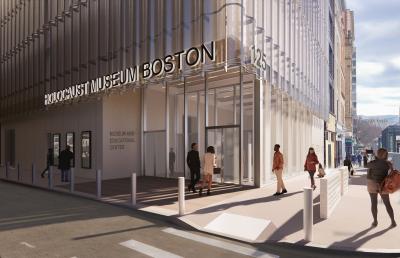Sea-Tac airport's Concourse C expansion project hits a milestone with the placement of final steel beam. Once completed in 18 months, the concourse will offer new amenities and tripled space, featuring sustainable design elements like solar panels and electric heat pumps.
Port of Seattle/SEA Airport photo
A Cat utility compactor works in a tight area.
Seattle-Tacoma International Airport celebrated its most recent construction milestone in December when Turner Construction and Apex Steel guided into place one of the final steel beams atop the expansion project's highest point.
In about 18 months, passengers at Sea-Tac can expect to enjoy a renovated Concourse C nearly tripled in size with a "wish list" of amenities.
Those include new dining and retail options and a Pacific Northwest-inspired gathering place anchored by the "tree at C" and even bleachers.
"The tree is real wood," said Janet Sheerer, the capital program leader, C Concourse expansion. "That was an important feature. Our design team really wanted to bring the outdoors in. Having that Pacific Northwest sense of place is actually part of our architecture design standard."
The $400 million project will add about 145,530 sq. ft. to the existing 81,000 sq. ft., along with four new stories, raising the concourse building to seven stories and making it the tallest building at the airport.
According to the website, "The topping out milestone is commonly celebrated in construction projects around the world and is part of an ancient Scandinavian tradition that celebrates the work and effort of those who worked on construction of the building."
Everyone involved in the project was invited to the ceremony and invited to sign the beam, Sheerer said.
"Our contractor made a speech about the tradition of the topping out ceremony, which is a really old tradition. The ironworkers were all there, and they're the ones really celebrating what a major achievement it is for them to get to that highest point on the building," she said. "So, they put a Christmas tree on it and an American flag on it and raised it by crane to the tippy top point and loaded it into place. Everybody took a little bit of a break and celebrated the milestone, which something we always want to make sure we take the time to do. It was pretty wonderful."
One of the major challenges on the project has been adding to the existing structure while it is still occupied, said Adam Olson, capital program manager, C Concourse expansion. "The primary space is on the lower level where we still have airport dining and retail storage. We had to go into multiple places there and drill piles, micropiles. So, we had to upgrade the existing foundation in a low-ceilinged area with people around and figure out how to make that safe and how to make it make it doable."
The other challenge came in adding "deep" foundations and stairwell foundations outside the building footprint.
"At an airport that's been around this long, there's always stuff in the ground that you weren't anticipating, including fuel from years ago and dirty soil that no one was aware of, or of lines that are being used still that no one knew, and we have to relocate," Olson said.
While those finds added new challenges, they also are not unexpected, and contractors generally have plans in place for handling and disposing of the fuel and soil.
"We have it built into the schedule to some extent," Sheerer said. "But again, if you don't know exactly when you're going to find it, you're really kind of relying on the contractor to be pretty flexible. If they find something, they're going to want to stop work in that location and go to work on another location. It's always kind of frustrating when it has to happen, but the way they phase the project allows them to react pretty quickly."
The project, a steel structure with a concrete slab on a metal deck, features numerous sustainable components, including electrochromic glazing on the south facade of the building that tints the glass under certain conditions like bright sun. The new Concourse C also will be the first building at Sea-Tac to feature solar panels on the roof.
"One of the other sustainability features are air source heat pumps — electric heat pumps," Sheerer said. "In the building itself, we're not using any natural gas or fossil fuels to condition the building. That's a big sustainability thing for us. Our dining tenants are not going to be using fossil fuels, which would probably be natural gas for cooking or heating. They have to buy special equipment.
"We've tried to be very transparent that that's what they're going have to come in and do. We had a good response to the RFP when they were put out. So, if you look at it from that standpoint, I think it was pretty well received."
The project is scheduled to be largely completed by May 2026. CEG
Lori Tobias
Lori Tobias is a journalist of more years than she cares to count, most recently as a staff writer for The Oregonian and previously as a columnist and features writer for the Rocky Mountain News. She is the author of the memoir, Storm Beat - A Journalist Reports from the Oregon Coast, and the novel Wander, winner of the Nancy Pearl Literary Award in 2017. She has freelanced for numerous publications, including The New York Times, The Denver Post, Alaska Airlines in-flight, Natural Home, Spotlight Germany, Vegetarian Times and the Miami Herald. She is an avid reader, enjoys kayaking, traveling and exploring the Oregon Coast where she lives with her husband Chan and rescue pups, Gus and Lily.
Read more from Lori Tobias here.
Today's top stories


















